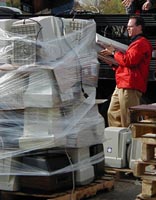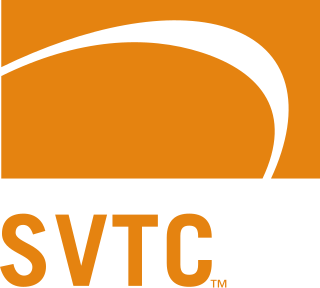
Photovoltaics (PV) is the conversion of light into electricity using semiconducting materials that exhibit the photovoltaic effect, a phenomenon studied in physics, photochemistry, and electrochemistry. The photovoltaic effect is commercially used for electricity generation and as photosensors.

Extended producer responsibility (EPR) is a strategy to add all of the estimated environmental costs associated with a product throughout the product life cycle to the market price of that product, contemporarily mainly applied in the field of waste management. Such societal costs are typically externalities to market mechanisms, with a common example being the impact of cars.

Green building refers to both a structure and the application of processes that are environmentally responsible and resource-efficient throughout a building's life-cycle: from planning to design, construction, operation, maintenance, renovation, and demolition. This requires close cooperation of the contractor, the architects, the engineers, and the client at all project stages. The Green Building practice expands and complements the classical building design concerns of economy, utility, durability, and comfort. Green building also refers to saving resources to the maximum extent, including energy saving, land saving, water saving, material saving, etc., during the whole life cycle of the building, protecting the environment and reducing pollution, providing people with healthy, comfortable and efficient use of space, and being in harmony with nature Buildings that live in harmony. Green building technology focuses on low consumption, high efficiency, economy, environmental protection, integration and optimization.’

Electronic waste recycling, electronics recycling ore-waste recycling is the disassembly and separation of components and raw materials of waste electronics; when referring to specific types of e-waste, the terms like computer recycling or mobile phone recycling may be used. Like other waste streams, re-use, donation and repair are common sustainable ways to dispose of IT waste.

Cadmium telluride (CdTe) is a stable crystalline compound formed from cadmium and tellurium. It is mainly used as the semiconducting material in cadmium telluride photovoltaics and an infrared optical window. It is usually sandwiched with cadmium sulfide to form a p–n junction solar PV cell.

Electronic waste or e-waste describes discarded electrical or electronic devices. Used electronics which are destined for refurbishment, reuse, resale, salvage recycling through material recovery, or disposal are also considered e-waste. Informal processing of e-waste in developing countries can lead to adverse human health effects and environmental pollution.

A waste picker is a person who salvages reusable or recyclable materials thrown away by others to sell or for personal consumption. There are millions of waste pickers worldwide, predominantly in developing countries, but increasingly in post-industrial countries as well.

Challenging the Chip is a 2006 book on "labor rights and environmental justice in the global electronics industry" edited by Ted Smith, David A. Sonnenfeld, and David Naguib Pellow. It is published by Temple University Press. In three parts, the book looks at global electronics, environmental justice and labor rights, and electronic waste and extended producer responsibility. In four appendices, the book also deals with the principles of environmental justice, the computer take-back campaign, sample shareholder resolutions, and the electronics recycler's pledge of true stewardship.

Industrial symbiosis a subset of industrial ecology. It describes how a network of diverse organizations can foster eco-innovation and long-term culture change, create and share mutually profitable transactions—and improve business and technical processes.

The Basel Action Network (BAN), a charitable non-governmental organization, works to combat the export of toxic waste from technology and other products from industrialized societies to developing countries. BAN is based in Seattle, Washington, United States, with a partner office in the Philippines. BAN is named after the Basel Convention, a 1989 United Nations treaty designed to control and prevent the dumping of toxic wastes, particularly on developing countries. BAN serves as an unofficial watchdog and promoter of the Basel Convention and its decisions.
This page is an index of sustainability articles.
Silicor Materials Inc. is a privately held manufacturer of solar silicon and aluminum alloy. Silicor is headquartered in San Jose, California, and its silicon purification operations are performed by its wholly owned subsidiary, Silicor Materials Canada Inc., in Ontario, Canada. Silicor also has a research and development facility in Berlin, Germany, and is currently building a commercial manufacturing facility in the port of Grundartangi, Iceland. The facility will have a nameplate capacity of 16,000 metric tons, with the ability to yield up to 19,000 metric tons of solar silicon each year. To date, more than 20 million solar cells have been made with Silicor's solar silicon.

Cadmium telluride (CdTe) photovoltaics is a photovoltaic (PV) technology based on the use of cadmium telluride in a thin semiconductor layer designed to absorb and convert sunlight into electricity. Cadmium telluride PV is the only thin film technology with lower costs than conventional solar cells made of crystalline silicon in multi-kilowatt systems.

Thin-film solar cells are made by depositing one or more thin layers of photovoltaic material onto a substrate, such as glass, plastic or metal. Thin-film solar cells are typically a few nanometers (nm) to a few microns (µm) thick–much thinner than the wafers used in conventional crystalline silicon (c-Si) based solar cells, which can be up to 200 µm thick. Thin-film solar cells are commercially used in several technologies, including cadmium telluride (CdTe), copper indium gallium diselenide (CIGS), and amorphous thin-film silicon.

Waste are unwanted or unusable materials. Waste is any substance discarded after primary use, or is worthless, defective and of no use. A by-product, by contrast is a joint product of relatively minor economic value. A waste product may become a by-product, joint product or resource through an invention that raises a waste product's value above zero.

Electronic waste or e-waste in the United States refers to electronic products that have reached the end of their operable lives, and the United States is beginning to address its waste problems with regulations at a state and federal level. Used electronics are the quickest-growing source of waste and can have serious health impacts. The United States is the world leader in producing the most e-waste, followed closely by China; both countries domestically recycle and export e-waste. Only recently has the United States begun to make an effort to start regulating where e-waste goes and how it is disposed of. There is also an economic factor that has an effect on where and how e-waste is disposed of. Electronics are the primary users of precious and special metals, retrieving those metals from electronics can be viewed as important as raw metals may become more scarce

SVTC Technologies was a technology services company that provided development and commercialization services for semiconductor process-based technologies and products. SVTC operated from 2004 to October 2012.

Joshua M. Pearce is an academic engineer at Western University and Michigan Tech known for his work on protocrystallinity, photovoltaic technology, open-source-appropriate technology, and open-source hardware including RepRap 3D printers.

Electronic waste is emerging as a serious public health and environmental issue in India. India is the "Third largest electronic waste producer in the world"; approximately 2 million tons of e-waste are generated annually and an undisclosed amount of e-waste is imported from other countries around the world.

The introduction and rapid expansion of solar technology has brought with it a number of occupational hazards for workers responsible for panel installation. Guidelines for safe solar panel installation exist, however the injuries related to panel installation are poorly quantified.

















